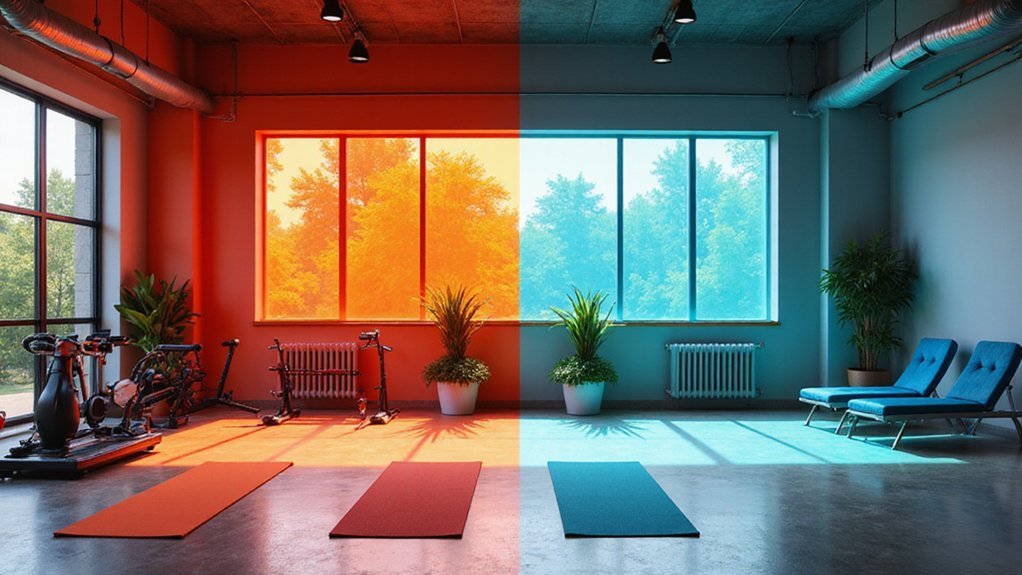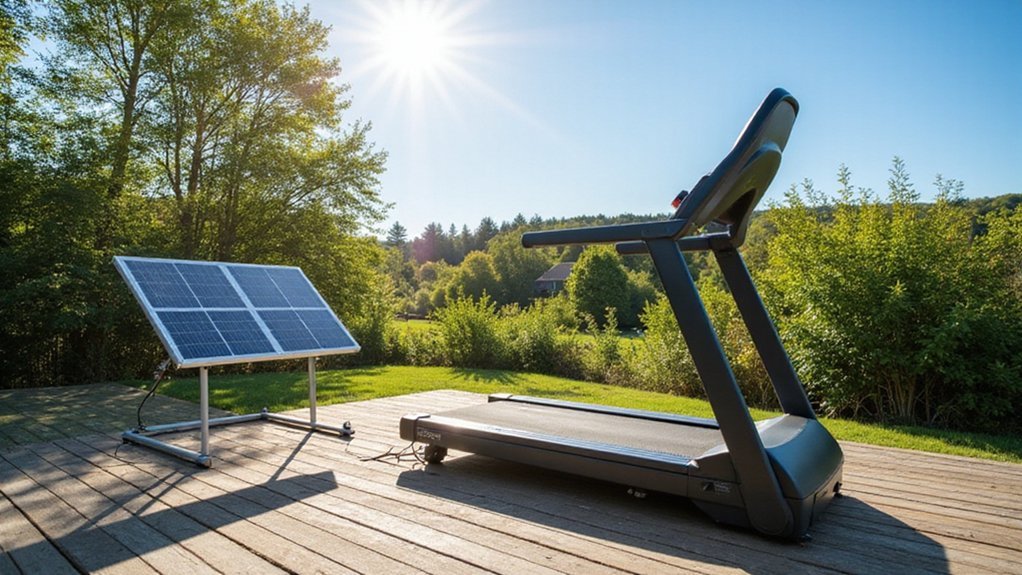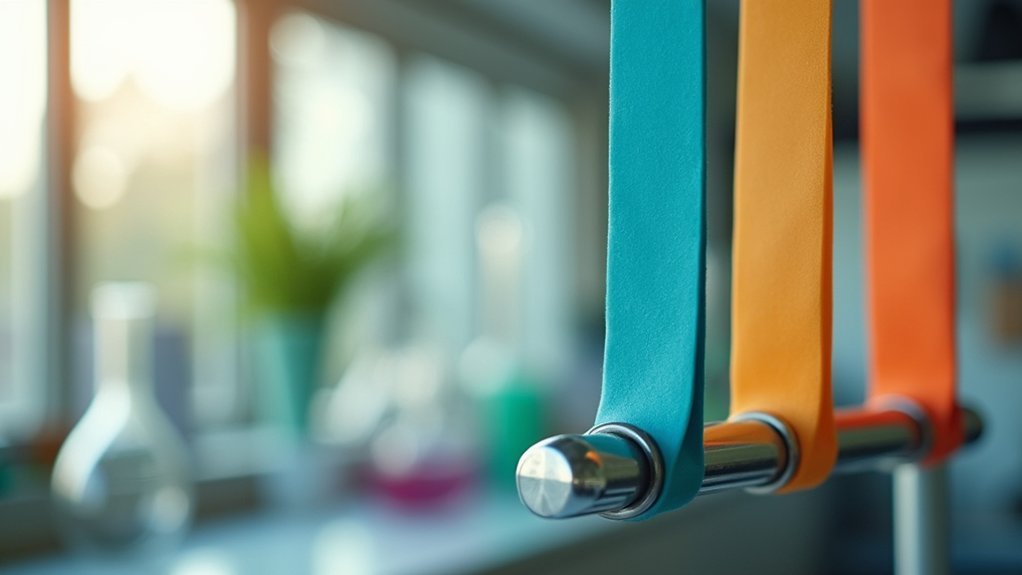Disclaimer: This content is for informational purposes only and does not replace professional medical advice, diagnosis, or treatment. Always consult a qualified healthcare provider before beginning any new exercise program.
Have you ever wondered why some gym spaces make you feel instantly motivated, while others leave you feeling unmotivated? Color isn’t just a visual element—it’s a psychological trigger that can transform your workout experience. The strategic use of warm and cool hues can dramatically influence your physiological and mental state, potentially boosting performance or inducing calm. What if the right color palette could be the secret weapon in your fitness journey? Prepare to uncover how design psychology might revolutionize your approach to exercise environments.
Key Takeaways
- Red and orange colors activate physiological responses, elevating heart rates and boosting energy in high-intensity workout areas like cardio zones.
- Blue and green tones create calming environments that promote mental clarity, focus, and recovery in yoga and stretching spaces.
- Strategic color placement acts as a psychological catalyst, stimulating performance in energetic zones and relaxation in tranquil fitness areas.
- Warm colors symbolize strength and motivation, while cool colors induce a sense of balance and mindfulness during different workout phases.
- Design elements leveraging color psychology transform physical spaces into intuitive psychological motivators that enhance overall fitness experience and member engagement.
The Science Behind Color and Human Performance

While color might seem like a simple aesthetic choice, scientific research reveals its profound impact on human performance and psychological states. In gym design, color psychology isn’t just about visual appeal; it’s a strategic tool that can transform your workout experience. Motivational colors like red and orange elevate heart rates and boost energy levels, making them perfect for high-intensity training zones. Conversely, calming blues enhance focus and mental clarity, ideal for yoga and mindfulness practices. Your color choices directly influence emotional states and physiological responses. Green tones promote balance and recovery, while yellow stimulates mental concentration and muscle energy. Understanding these nuanced color interactions allows fitness spaces to intentionally craft environments that optimize performance, motivation, and overall well-being through thoughtful, scientifically-informed design strategies.
Warm Colors: Igniting Workout Intensity
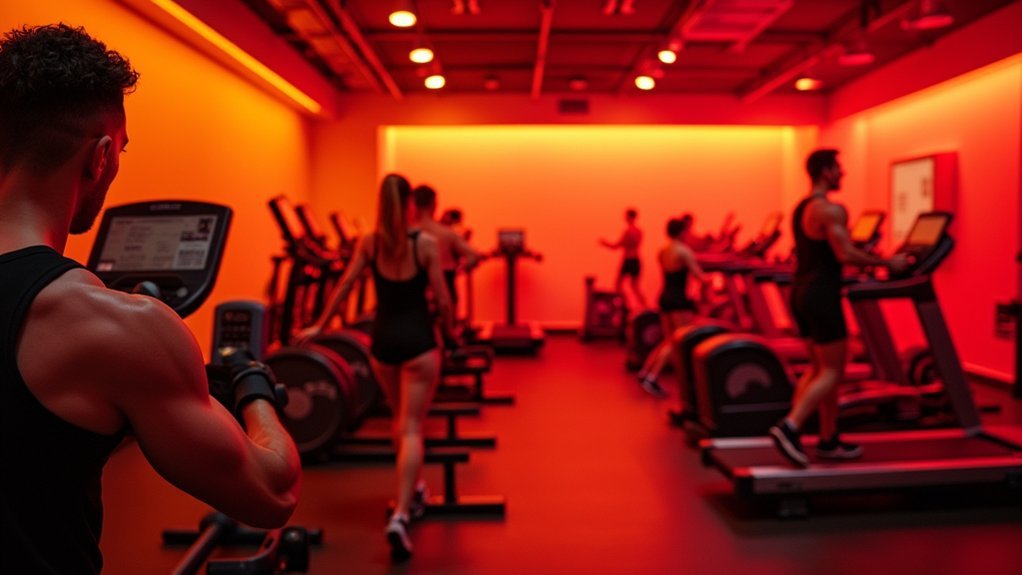
Building upon the scientific foundations of color psychology, warm colors emerge as powerful catalysts in gym design, specifically targeting performance enhancement and psychological stimulation. In fitness centers, warm colors like red and orange strategically activate physiological responses, increasing heart rates and adrenaline levels within high-intensity workout areas. These dynamic hues symbolize energy and strength, motivating gym-goers to push beyond perceived limitations.
The key lies in balanced application. While warm colors can ignite workout intensity, excessive use might trigger stress or aggression. Successful color psychology implementation requires careful zoning—using warm tones in spin studios and cardio spaces, while moderating their presence with neutral counterparts. This approach guarantees an invigorating environment that stimulates performance without overwhelming participants’ sensory experience.
Cool Colors: Creating Calm and Focus

Tranquility becomes a strategic design element when cool colors enter the fitness landscape. You’ll discover that blues and greens aren’t just aesthetic choices—they’re powerful psychological tools for creating calmness and focus in workout spaces. These cool colors transform yoga areas and recovery zones into sanctuaries of relaxation, promoting mental clarity and physical restoration.
Strategic Color Placement in Fitness Spaces
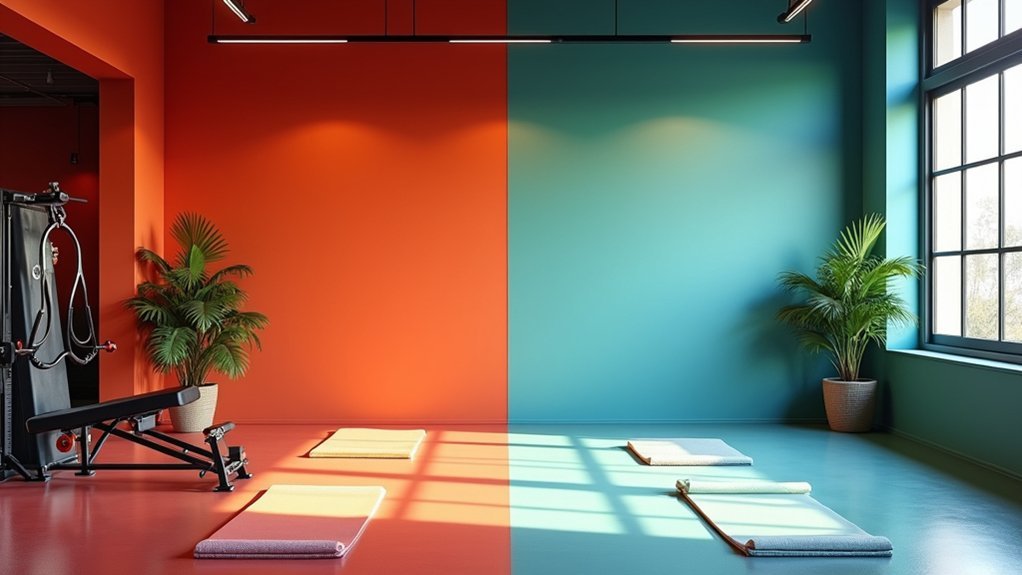
Because color isn’t merely a visual element but a psychological catalyst, fitness spaces demand strategic color placement that transforms environments into dynamic, purpose-driven zones. By leveraging energizing colors and calming tones, you’ll create workout zones that optimize performance and emotional well-being.
- Red in cardio areas ignites adrenaline and heart rates
- Blue in strength training zones promotes mental focus
- Yellow accents encourage social interaction and motivation
- Neutral backgrounds prevent visual strain and maintain color balance
Strategic color placement isn’t just aesthetic—it’s a scientific approach to designing fitness environments that respond to human psychological needs. Each color selection influences perception, mood, and physiological responses, turning your gym from a simple exercise space into a holistic performance ecosystem. The key lies in understanding color’s nuanced impact and implementing it with precision.
Balancing Energetic and Relaxing Color Palettes
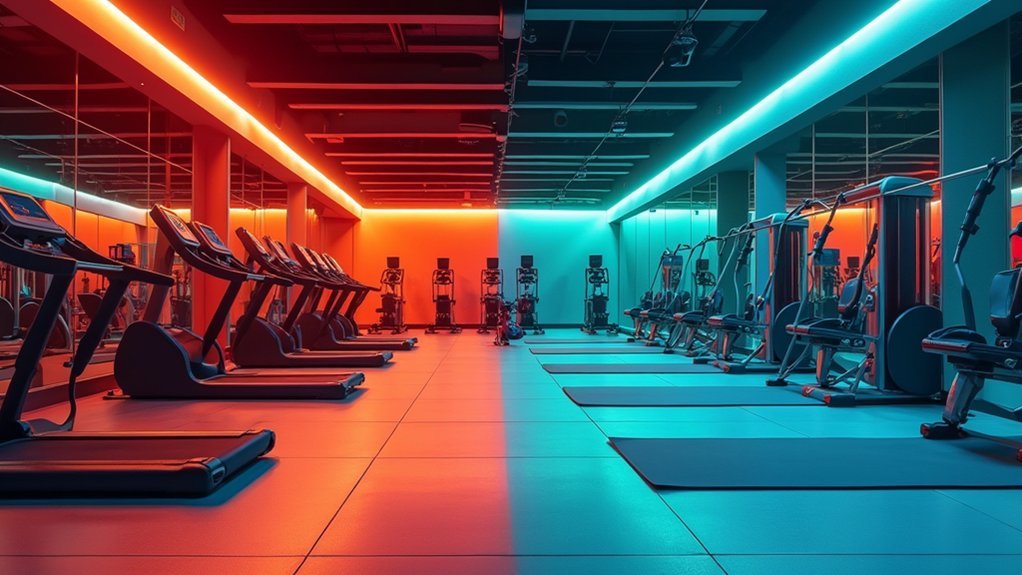
While color psychology transforms gym design, creating balanced palettes requires nuanced understanding of physiological and psychological responses. By strategically integrating energizing and calming colors, you’ll craft gym areas that support diverse fitness experiences.
| Energizing Colors | Calming Colors |
|---|---|
| Red (Motivation) | Blue (Tranquility) |
| Orange (Intensity) | Green (Balance) |
| Yellow (Vitality) | Soft Gray (Neutrality) |
Understanding these design elements’ psychological effects allows you to modulate users’ emotional states. Vibrant colors in cardio zones spark intensity, while muted tones in recovery spaces promote relaxation. Neutral base colors mitigate color overwhelm, creating versatile environments that smoothly shift between high-energy and meditative spaces. This holistic approach guarantees your gym isn’t just a physical space, but a thorough wellness ecosystem that responds to varied psychological and physiological needs.
Impact of Color on Different Workout Zones
Since color psychology deeply influences workout experiences, gym designers must strategically map chromatic environments to specific fitness zones. The color design impacts how you perceive and engage with fitness equipment across different workout spaces.
- Energizing colors like bright red and orange spark motivation in cardio areas, elevating heart rates and performance
- Soft blues and greens in yoga studios create tranquil environments that enhance mindfulness and mental restoration
- Deep blues and bold reds in strength training zones amplify focus and intensity during muscle-building workouts
- Green tones in recovery spaces promote physiological balance and mental relaxation after high-intensity sessions
Psychological Triggers of Color in Exercise Environments
When examining color psychology within fitness environments, researchers have uncovered profound neurological and physiological responses that transform exercise spaces from mere functional areas into dynamic psychological landscapes. Color plays a pivotal role in manipulating emotional and physical states, with energizing reds stimulating adrenaline in high-intensity workout areas and calming blues inducing tranquility in recovery zones. Your brain’s subconscious interaction with color wavelengths can trigger specific psychological experiences, influencing motivation, performance, and stress relief. By strategically leveraging color combinations, designers can create environments that not only guide physiological responses but also enhance mental engagement. The intentional selection of hues becomes a nuanced tool for modulating workout experiences, allowing individuals to navigate different emotional and physical states through carefully curated visual stimuli.
Color Selection for Specific Fitness Disciplines
Because color psychology profoundly influences exercise experiences, fitness facilities must strategically design environments that align with specific workout disciplines. Perfect gyms understand how color affects participant performance and emotional states across different Fitness activities.
- Vibrant reds and oranges ideal for areas requiring high-energy output like spin classes
- Calming blues and greens create a sense of tranquility for yoga and pilates practices
- Deep blues and bold reds optimize strength training zones by enhancing focus and intensity
- Soft greens and neutrals promote recovery and mental reset in post-workout spaces
Scientific research demonstrates that color selection isn’t merely aesthetic but a critical psychological tool. By thoughtfully integrating color psychology, fitness environments can strategically influence participant motivation, performance, and overall workout experience, transforming standard exercise spaces into purposefully designed sensory landscapes.
Optimizing Member Experience Through Color Psychology
Gym design transcends mere aesthetic considerations, transforming color psychology into a strategic tool for optimizing member experience. By leveraging energizing colors and calming colors, fitness spaces can dramatically enhance workout performance and member satisfaction. Your environment directly influences motivation, focus, and engagement.
| Color Impact | Psychological Effect | Fitness Zone |
|---|---|---|
| Red/Orange | High Intensity | Cardio Area |
| Blue/Green | Calm & Focus | Yoga Space |
| Yellow | Mood Uplift | General Area |
Color combinations strategically deployed create an inviting atmosphere that subtly guides member behavior. Deeper hues in strength training zones maintain intensity, while softer yellows generate cheerful environments. Color psychology isn’t just design—it’s a sophisticated approach to creating responsive, performance-driven fitness spaces that intuitively support your fitness journey, transforming physical spaces into powerful psychological motivators.
Frequently Asked Questions
What Are Energetic Colors in Psychology?
You’ll find energetic colors are vibrant hues like red, orange, and yellow that evoke psychological effects through warm tones, creating emotional impact via color symbolism and stimulating physiological responses in specific contexts.
What Are the Colors for Fitness Psychology?
You’ll be electrified by color’s mind-blowing power! Colors dramatically shape your fitness journey through hue effects, triggering psychological responses that influence emotional engagement, motivational levels, and environment impact during your workout experience.
What Colors Are Best for Gym Motivation?
You’ll boost motivation through vibrant reds and oranges that trigger emotional responses, coupled with strategic color design. Your gym’s visual stimulation and personal preferences matter, creating an ambiance that energizes and inspires your fitness journey.
What Color Is Associated With the Gym?
Like a powerful pulse, you’ll find red dominates gym color trends, energizing spaces with its mood-enhancing impact. Strategic color choices in branding and design elements transform workout environments, creating an atmosphere that motivates and elevates your fitness journey.
Conclusion
Color psychology isn’t just design—it’s a performance catalyst. You’ll transform your fitness environment by understanding how strategic color placement can elevate mental and physical experiences. Whether you’re seeking high-intensity motivation or zen-like recovery, colors aren’t mere aesthetics but powerful psychological triggers. Your gym’s palette isn’t just what you see; it’s what you feel, driving emotional and physiological responses that can dramatically enhance workout outcomes.
